Cambodia, Angkor, Main monuments 9th-13th centuries
Today, the Angkor Archaeological Area is a large park peppered with relatively isolated temples built of brick, laterite, and sandstone. Many of the temples are overgrown with jungle—large trees have plunged right through some of the temples’ roofs and entangled their powerful roots with the complex. Tourists explore the more than forty temple ruins, marveling at the elaborately carved surfaces and the staggering number of sacred structures that survive in varying states of preservation.
However, Angkor was once the largest preindustrial city in the world. The jungle was cleared and the temples were alive with rituals that included music and dance. People built their houses in the agricultural lands between the temple compounds. In addition to these temples, vast irrigation systems were engineered to divert rivers and create massive reservoirs that watered the fields. Angkor was a great city where the sacred and the urban intersected and flourished for a period of more than five hundred years (ca. 9th–13th centuries).
Far from frozen in time, Angkor has continually transformed since its founding in the ninth century. It continues to change each day. Best known for the temple of Angkor Wat, today the Angkor Archaeological Area is one of the world’s most popular destinations for tourists and world travelers. It is also the subject of abundant scholarly research. Recent archaeological projects using LIDAR (Light Detection and Ranging) scanning have peeled away the layers of time to reveal significant man-made changes to the earth’s surface. A seemingly natural cliff is a thousand-year-old dam. A series of low-lying hills is a village. We now know that Angkor was a sprawling, highly populated city that made permanent changes to the environment.
There is much to read about Angkor. Learn more about the region by selecting specific shrines to explore in this map. Delve further with the resources in our selected bibliography.



